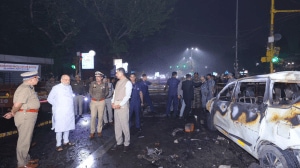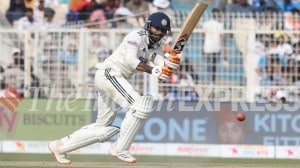Mother of a thousand suns
I first came across Hazaar Chaurasi Ki Ma in the form of a play, in Calcutta. I was moved by the subject but didn't think I was ready to mak...

I first came across Hazaar Chaurasi Ki Ma in the form of a play, in Calcutta. I was moved by the subject but didn’t think I was ready to make a film then, because the Naxalite movement was not yet over this was in the early ’80s. Then, this time last year, I came across the English translation of the novel in a book shop. While going through the book, the first question that struck me was: "Who is the mother?" The only name that came to mind was, Jaya Bachchan.
We had kept in touch at one stage, she felt that Amitabh and I should do a film. But at that time I didn’t have a story for him. Every time we met she would ask me what was happening. I used to tell her, "Everything else will fall into place, but you should agree first." Initially, she said her priority were her children but on the last few occasions, she said, "If there is something interesting, let me know."
 The same evening I called her up and said, "I am bringing you a book, see if you are interested." After two or three days she rang me upand said she liked the book. In two weeks, I had the first draft ready. I decided, with Mahasweta Devi’s consent, to change the end, bring it to the ’90s and make the film more relevant.
The same evening I called her up and said, "I am bringing you a book, see if you are interested." After two or three days she rang me upand said she liked the book. In two weeks, I had the first draft ready. I decided, with Mahasweta Devi’s consent, to change the end, bring it to the ’90s and make the film more relevant.Once Jayaji read the book and the first two drafts, she said, "Please take the script back. If I read it again I will start asking questions. I have got the essence of the character. I cannot prepare for the role, learn the lines or develop a certain attitude. You tell me the scene on the set and I will do it." I didn’t send anyone to collect the script and two days later she sent her man. "I don’t want the script in front of me," she said.
But even as the third draft of the script was ready, I still didn’t have funds to make the film. I think Hazaar… was possible due to three miracles. The first being, Jayaji agreeing to do the film. The second was that the Chairman of Sahara India, Subroto Roy, agreed to support the project and suddenly things started moving. The third important factor was that my old friend ManmohanShetty of Adlabs stepped in with additional funds.
We started shooting on July 1, 1997 and by August 29, we had the censor certificate in hand.
Once Jayaji was on the sets, she was all there. It didn’t look like she was working after a gap of 16 years. She just took the entire unit along with her, even a grouchy person like me towards the end of the film I had actually started humming songs. Anupam (Kher) once asked, "What has happened to Govind?" When she was not on the sets one felt something was missing there was this strange silence.
As an artist, she contributed immensely to the texture of the character, from her personal experience as a mother. Her son is almost the age her son is supposed to be in the film. A lot of details came out of this about how children behave and how mothers behave with their children.
In terms of her sensibility as an artist, she was very much like what one wanted from an actress who was playing Sujata. She had to have tremendous control over her expressions. Therewas no room to make the performance stylised, bring everything upfront or get melodramatic. We needed that quality of understatement.
The other thing was to avoid making it sentimental which could have happened very easily, because it was about a mother-son relationship. She was the one who resisted that the most.
And however much she said she doesn’t prepare, she has a process. There is this beautiful scene in the film, where Sujata cries for the first time. Her son’s room is ransacked by the police and his mattress has been ripped open. Her son’s photograph is lying on the ground. I told her, "I want you to feel that this is not just your son’s room, but his body which has been ravaged. You come in, switch on the light, pick up the photograph and sit down. It is a private moment because you are giving-in to your feeling for the first time."
We shot the scene in two takes. Two days later I asked her, "How did you manage this moment?" I had been very touched we all were and there was pin drop silenceon the set. She said, "I just knew that it was. You said this is the body of my son. The moment I entered the room, I saw the mattress ripped open (it was red and white in colour), and something happened. Everything just became real." She did not try to analyse the situation. There was no rehearsal. I didn’t even know at what stage I would start moving the trolley towards her or when she would start crying.
Jaya took the cast with her. She was the key note in the orchestra and I discovered that people just responded to the way she looked. As soon as a scene started she would have a certain expression on her face and people used to get their cues in terms of emotional response, or the performance quality, from her. If acting is reacting, then she was the cue.
As an actress she has matured a lot. Her understanding of life is immense. And her sensibility even more sophisticated. She is very controlled. The quality of restraint that she has is very rare she is not insecure about projecting an emotion.Getting the depth of emotion by projecting very little, comes from tremendous maturity and confidence.
When she walked on to the set the first time, we didn’t think she had ever left. It is like an accomplished singer who performs after a long gap she didn’t look like an artiste who was out of practise and was trying to get back into step.
And because of her I started enjoying the shoot. I am a very tense director. But here, I am told, I was different. I don’t know about all that, but I just enjoyed myself. It is one of my well-realised projects, like Tamas. It gave me that kind of satisfaction. All along I had an unreal feeling about this film like a miracle was happening. And the first and most vital one was Jaya Bachchan.
Hazaar Chaurasi Ki Ma opens next week.































